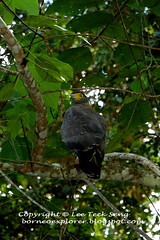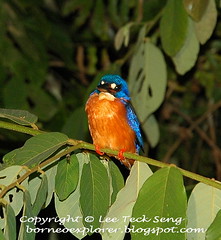Wednesday, January 14, 2009
Monday, December 24, 2007
Thursday, November 22, 2007
Thursday, November 1, 2007
Crested Serpent Eagle

The Crested Serpent Eagle, Spilornis cheela is a bird of prey. Like all eagles, it is in the family Accipitridae.The Crested Serpent Eagle can be found in a large geographical region from South Asia, including India and Sri Lanka, to Southeast Asia, extending to southern China and Indonesia. This forest bird nests in treetops near fresh water. Its nests are constructed with sticks and contain not more than a single egg at a time.The Crested Serpent Eagle is a medium large raptor
at about 55-75cm in length. Adults have dark brown upperparts and head,
and have a hooded appearance at rest. The underparts and underwing
coverts are pale brown. In soaring flight, the broad wings are held in
a shallow V. The tail and underside of the flight feathers
are black with broad white bars. When perched, they appear large headed
and owl-like due to the shape of the face and positioning of the eyes.The call is a distinctive Kluee-wip-wip with the first They call a lot in the late mornings from perches or as they rise on the thermals in the mornings.
Sexes are visually similar, but young birds have a whitish head, underparts and underwing, the latter showing darker barring.
Blogged with Flock
Blue-eared Kingfisher

The Blue-eared Kingfisher, Alcedo meninting, is found in South and South-east Asia. This is a small kingfisher almost identical to the Common Kingfisher, Alcedo atthis. The Blue-eared Kingfisher is distinguished from the Common Kingfisher by blue ear coverts, darker and more intense cobalt-blue upperparts with richer rufous under parts.The juvenile Blue-eared Kingfisher has similar rufous ear-coverts like the Common Kingfisher; but it usually shows some mottling on the throat and upper breast which disappears when the bird reaches adulthood.The average length of this kingfisher is 16cm. It is found near pools and streams in dense evergreen forest, situated under 1000m of altitude.
Blogged with Flock
Wednesday, September 19, 2007

Saltwater Crocodile Earth’s largest living crocodilian—and, some say, the animal most likely to eat a human—is the saltwater or estuarine crocodile. Average-sized males reach 17 feet (5 meters) and 1,000 pounds (450 kilograms), but specimens 23 feet (7 meters) long and weighing 2,200 pounds (1,000 kilograms) are not uncommon. |

Pacific Swallow
Hirundo tahitica
Layang Layang Pasifik (Malay)
Pacific Swallows eat insects, catching them during flight. To feast on swarming insects, they may join other birds like Swifts. But unlike Swifts that simply trawl the air with their mouths open, Swallows don't hunt on the wing. They perch and wait, then actually chase after individual prey and perform aerial acrobatics to catch them. Swallows also hunt at lower levels than Swifts.
Unlike Swifts, Swallows can perch and also come to the ground to drink or gather nesting material.Pacific Swallows are found everywhere, but usually near water and open country. In Singapore, they are particularly common along the coasts, and also found in mangroves.Migration? Pacific Swallows are resident. They are never found in such huge flocks as the visiting Barn Swallows, which they closely resemble.Although they may feed together with Barn Swallows, they don't join the Barn Swallows huge roosts.Breeding: Resident Pacific Swallows nest on vertical surfaces with overhangs to protect their mud nest (which would disintegrate in the rain). These may be cliffs with an overhang but are often bridges, dams and other man-made structures. But they shy away from humans and prefer unoccupied buildings. They build solid nests out of mud pellets brought by the beakful from puddles and river banks. Combined with dry grasses, these pellets are arranged much like bricks to form shallow cups. These may be lined with dry grass and feathers. At a particularly suitable nest site, they may form large colonies. Usually 3 white eggs are laid. These are long and pointed and have brown spots.
Subscribe to:
Posts (Atom)

